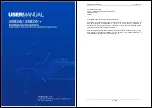
Feature
Specification
5% to 90% (RH), non-condensing short term (< 1% of operational
hour per year)
Storage relative humidity
5% to 90% (RH)
Operating altitude
Maximum: 10,000 feet (3,048 meters)
No performance degradation up to 3,117 feet (950 meters)
IEEE standards
The Edge 600 Series complies with the following IEEE standards:
•
802.1ab—LLDP
•
802.1ax—Layer 2
•
802.1d, 802.1w, 802.1s, 802.1x—Mgmt/Security; 802.3x—Layer 2
•
802.3—1000BASE-KX
Safety standards and compliance agency
certifications
•
CUS UL 60950-1, 2nd Edition
•
CSA 60950-1-03, 2nd Edition
•
EN 60950-1, 2nd Edition
•
IEC 62368-1
•
EN 60825-1, 1st Edition
•
EN 60825-1 Safety of Laser Products—Part 1: Equipment Classification Requirements and User’s Guide
•
EN 60825-2 Safety of Laser Products—Part 2: Safety of Optical Fibre Communication Systems
•
FDA Regulation 21 CFR 1040.10 and 1040.11
•
IEC 60950-1, 2nd Ed, including all National Deviations and Group Differences
Agency compliance
The Edge 600 Series complies with the following safety and agency requirements:
USA Federal Communications Commission statement
CAUTION:
The use of external signal amplifiers in-line with the transceiver antennas is strictly prohibited.
CAUTION:
Use only the antenna(s) which have been approved by the applicant. Non-approved antenna(s) may produce
unwanted spurious or excessive RF transmitting power which may lead to a violation of FCC/IC limits and is prohibited.
This device complies with Part 15 of the FCC Rules. Operation is subject to the following two conditions:
1) This device may not cause harmful interference, and (2) this device must accept any interference received, including
interference that may cause undesired operation.
This equipment has been tested and found to comply with the limits for a Class A digital device, pursuant to Part 15
of the
FCC Rules.
These limits are designed to provide reasonable protection against harmful interference in a residential installation. This equipment
generates, uses and can radiate radio frequency energy and, if not installed and used in accordance with the instructions, may cause
harmful interference to radio communications. However, there is no guarantee that interference will not occur in a particular installation. If
this equipment does cause harmful interference to radio or television reception, which can be determined by turning the equipment off
and on, the user is encouraged to try to correct the interference by one of the following measures.
Reorient or relocate the receiving antenna.
Specifications
21








































